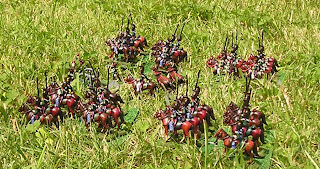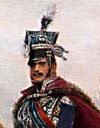Continuing from the earlier post, by turn 8 the French spearhead had cut across the bridge and almost reached the beaches where British infantry were just starting to land...
The first phase of the battle was certainly done and the French boys were pleased with the results, most certainly they did not consider the loss of the Dragoon division of much import, they had traded the Dragoons for two battalions of Russians and a full battery of artillery.
Now a slowing of the French happens, while the infantry divisions come to grips with each other, the Russians were pounding the columns moving now into range, the first salvos from the Siege artillery were also having effect, now that they had turned to face the left flank and had the Guard cavalry in canister range!
Orders had also reached the Russian Hussars whom were rushing to the new 'center' of the field.
 |
| The flank turned, now the Russians were reacting to the situation |
The Hussar division executed its orders perfectly, striking from the far side of the river and applying pressure just as the Guard Cavalry was smashing through two Russian squares and spiking one half battery of foot artillery.
 |
| French Hussars face no opposition until across the river |
The situation on the far side of the church was desperate for the Russians and they were to all ultimately be broken up by the charge of the Empress Dragoons. Guard heavy cavalry - OUCH!
 |
| French Guard cavalry is just too powerful, even for steady squares! |
The French plan was just one turn too slow, or the Russians sacrificed just enough to slow them down, as the British light division began its landings.
 |
| British battalions start landings |
For ground gained, this was the French 'high water mark' - as the Chasseurs a Cheval were blown, tired, had casualties and were facing a steady British square with another line coming up behind. The Chasseurs wisely chose to turn back and fall hard upon the Russian HQ driving it deep into the center of the field.
 |
| French spearhead reached to just short of the beaches |
This was now into turn 10, and the British cavalry started landings, on the farther beach, with no artillery the French could not do anything about these landings. The nature of the battle was now shifting as another full division was about to land here after the cavalry had cleared off.
 |
| British Light Dragoons land on the second beach, well beyond French range. |
The French and British spearheads were at one another now.
 |
| French and British spearheads, as close as they would get this time ... |
The tide was turning, ever so slowly for the Russians favor. The French cavalry spearhead would have to recover and take refuge behind the church from the relentless pounding it was taking from the massed Russian batteries and siege artillery. Now the Hussars were moving, further orders had reached the Russian Grenadier formation and the Cuirassiers. The next stage of the battle was about to start ...
 |
| Russian Cuirassier Division |
The long French columns of infantry had now started to come clear of the woods, though battered by the Russian guns they were still moving....
 |
| French infantry columns come out from woods gap |
The Russians continued to deliver fire into the columns as they formed up to advance.
 |
| Russian cannon deliver a pounding to French units |
The French cavalry had no choice other than seeking cover behind the church from the massed artillery batteries and siege guns. All formation of horse now had some casualties and or were blown from continued charges.
 |
| again a view of scale with my 6 year old in the distance |
 |
| sheltered by the church the French cavalry would need time to rest before taking on any further action |
While the French horses rested the British Light Dragoons were riding hard for the edge of the mangrove forest and the center of the now Allied line.
 |
| British Light Dragoons |
Meanwhile the rest of the British beachhead was consolidated with half of the brigade forming square to hold off any opportunity charges by the nearby French cavalry...
 |
| British beachhead held by squares and rifles in the mangrove woods |
 |
| The British view of the French cavalry |
The area around the Church was definitely in French control, though they would have to pay for holding it with many more horsemen as the Russian massed batteries and Siege artillery were in canister range.
 |
| the Church region |
 |
| Russian massed batteries and Siege artillery firing |
Meanwhile by turn 11 the French columns had become exposed from the woods gap to the fire from Russian foot batteries with attached infantry. The approach to the lines would have to be paid for....
 |
| Russian infantry support artillery laying down fire into the woods gap |
 |
| emerging from the woods line these French columns would have to weather the canister storm |
From the Russian right, the Hussars had emerged into the center of the field, now to threaten these advancing French columns and provide much needed cover for the exposed massed batteries and the moved headquarters.
 |
| Russian Hussars streaking into the center in front of the Grenadier battalions |
 |
| Russian headquarters in some disarray after fleeing from French Guard Chasseurs |
It was here, at the end of turn 11 that the players all melted from the heat. One young player had slightly scalded his fingertips with the metal bases, they had become so hot in the bright sunlight!
Here then is the view of the field at the moment we stopped, the score was 2-2, with each side needing another 10 battalions or squadrons defeated to win/lose. At the moment the French are in advantage in the ground having invested the Russian left flank. Though slow to respond the Russian army was moving and would be in position to threaten the 9 battalions closing in on the center right.
 |
| The field as of the end of turn 11, where we left it. |
Who do you feel would win this battle?
What are your thoughts about doing such a game in the garden?
There were only 2 confirmed casualties in the minis, one musket on a Russian infantryman was broken off and this French Hussar became separated from his mount. The repair was done that night on the horseman, the loss of the musket is not critical.
 |
| only limited wear on the minis in this battle |















































































































